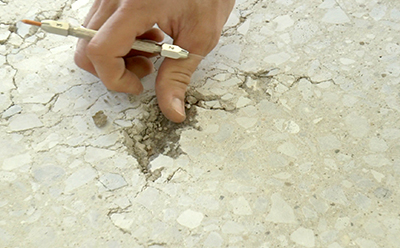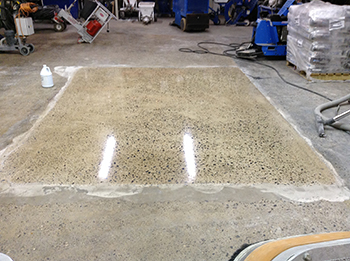Should a grout be installed on every polished concrete floor? The short answer is... no.…

1384 Bungalow Rd.
Morris, Illinois, U.S.A.
Can a “soft” concrete floor be polished?

In my experience, ANY concrete slab can be polished. The limitations though to ANY concrete slab being polished is usually budget and time.
The general rule of thumb is that the softer the concrete is when you start the process, the more work and materials it will take to make it look good. More labor, more diamond tools, more chemical will all be required to make a soft slab look like a show-piece and all these extras cost time and money.
If the project can afford more of both, then it’s no problem whatsoever to polish a soft slab.
Before considering undertaking a project that has soft concrete, clearly understand that:
- Aggregate exposure cannot be controlled. The depth to which a slab must be ground depends on which amount of surface needs to be removed to expose strong concrete.
- Color differences and linear marks may appear. During installation of the slab, some of the aggregates may have been pushed together differently leaving concentration and arrangement variation.
- Porosity and micro-pitting will be prevalent. After the first 1/32″ (.5mm) of concrete is removed, air holes will become more common and likely need to be filled.
Chemicals
Any slab that is soft needs extra densification. Do not believe for one second that different bonds of diamond tools will overcome a soft matrix of concrete. Yes, a different bond of tool will last more or less time based on its bonding but it has NOTHING to do with making the matrix of the concrete stronger or the floor to be cut more flat by overcoming the hardness disparity between matrix and aggregates. Soft floors need more densifier; usually double, if not more.
Diamond Tools
Any tool that is used before the first coat of densifier should be of the sort that can handle the abrasive nature of a soft concrete slab. Whether it be your first metal tool or up to your last metal tool (if something is prohibiting using densifier after your first cut) plan that tool consumption will be higher until that slab is densified unless you switch to a hard bond tool.
Execution

During the “Mockup Phase” ”“ (always, always, ALWAYS perform a mock-up when a project like this is to be done!) ”“ grind the floor with a tool that can remove the top layer of concrete to a uniform exposure and does not cut uncontrollably. In the case of Substrate Technology Inc.’s offering, a #0H on a P/M Machine with all the weights on the top handle works perfectly for this.
The floor should be consistently scratched and have no variation or low spots that have not been touched by the process. Then clean the surface thoroughly and apply your favorite densifier at one and a half times the manufacturer specified rate.
After the densification, whether using Substrate Technology Inc.’s or other diamond products, begin your polishing with your first metal polishing step. In the case of Substrate Technology Inc.’s offering, the EGT or CLC #1 will be the first step. Proceed on through the polishing process and then apply the densifier again after your first resin step. Finish by completing each successive step to whatever final grit the project requires to meet the specified shine.
There is much more that can be offered on this topic of “Polishing Soft Concrete.” My advice is always to consult the people that make the products first before considering any other sources for what actions you should take. At least by now knowing how to accommodate soft concrete, you will have the confidence to proceed as expected or to stop work and get in touch with some help.
© Substrate Technology, Inc.
For any clarification of the above or to discuss your unique situation, please do not hesitate to contact Substrate Technology Inc. or any of its authorized dealers for more help and advice. We are all here to supply you with solutions that save you time and make you money.
Related Posts
- Should a grout be installed on every polished concrete floor?
- Should I use diamond pads to maintain my polished concrete floor?
Should I use diamond pads to maintain my polished concrete floor? Yes, but not everyday.…
- I have scratches everywhere in my polished concrete! Why?
I have scratches everywhere in my polished concrete! Why? There are many possible reasons for…